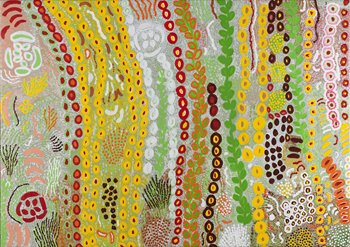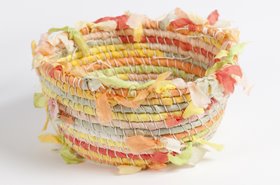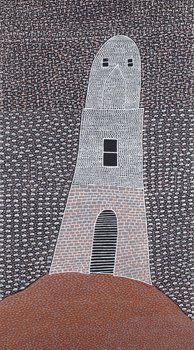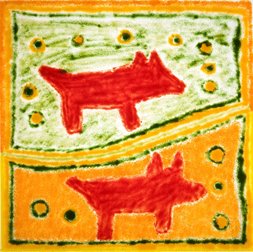 Colouring the Country:
Colouring the Country:
Celebrating artistic practice
from the Pilbara region
It’s quite an achievement when an exhibition grows from a very small initiative to an entrenched ‘must-see’ show on the Indigenous visual arts calendar. It’s even more of an achievement when the life of that exhibition has evolved over a decade and continues to grow in stature. Such is Colours of our Country, an exhibition of work from artists whose country lies in the Pilbara region of Western Australia.
Colours of our Country began as an initiative of Rio Tinto Iron Ore in 2006, as part of their commitment to community investment and culture. Partnering with a range of artistic institutions, as well as regional and community based art centres, the idea to support regional sustainability by showcasing emerging Indigenous artists was not unique, but certainly singular within the Pilbara region. The Pilbara region has not been known for its artistic output in the way that the Kimberley region of Western Australia has been, for example, with its myriad remote community art centres and Indigenous arts superstars.
It would be disingenuous to assume that the focus on the Pilbara had nothing to do with Rio Tinto’s interest and position within that area in terms of its mining contracts. Its synergistic interweaving of its corporate interests and the interests of the community members of Roebourne and other regional centres across that vast tract of country, presents an opportunity to investigate and unpack the very real dilemmas and questions that arise when those in power offer opportunities to those whose power base, in western terms, has traditionally been limited. There are very few instances in which accounts such as these – the story of the Colours of our Country exhibition - can be told in only black and white terms (forgiving the pun), and indeed this story is still unfolding.
A critical question to ask first when thinking about working with Indigenous artists or communities is, “has the community asked you to work with them?”
There are many non-Indigenous organisations and individuals that have ideas about how to support Indigenous Australians that are often unconnected to the ideas that the communities themselves have for their advancement and self-determination. In the case of the Colours of our Country exhibition, for some time Indigenous artists throughout the Pilbara region had seen the success of artists in the Kimberley and had spoken together about ways in which they could increase the representation of their work and style within the broader and highly competitive Indigenous Australian contemporary visual arts landscape.
The idea of an annual exhibition program in the capital city of the state, with buy-in from key government and corporate stakeholders was a strong draw-card for the Yindjibarndi and Ngarluma peoples of the Pilbara, whose practice is supported by the Yinjaa-Barni Art Centre (incorporated in 2007) and the Roebourne Arts Group (which commenced in 2005 trading as a not for profit entity) respectively. The very first show came together in Perth in 2006, with funding support from Rio Tinto. The conversations between Indigenous community groups about utilising mining money to support a show of work from Indigenous artists, whose country was being impacted upon, must have been confronting and complex. The success of that initial exhibition, and indeed subsequent exhibitions, has gone some way to allaying some of the fears and concerns surrounding this most complex and multi-layered issue.
A web of stakeholders whose primary aims vary markedly supports Roebourne Art Group. These include Rio Tinto, Woodside, the Australian Government, Ngarluma Aboriginal Corporation, the Museum of Contemporary Art Sydney, the Aboriginal Arts Centre Hub and Artsource. The funding that these bodies provide can allow the artists who participate in the group to undertake certain things, such as (but not limited to) professional development, education and training in marketing and IT, support for delivery and transportation of artworks and facilitates the ongoing development of the centre in a range of areas including governance, employment opportunities and financial management. The Indigenous Employment Initiative (IEI) program of the Commonwealth Ministry for the Arts provides employment opportunities that go beyond the successful operation of Roebourne Art Group as a business.
 How opportunities are realised - and indeed the broader vision of what the art group wishes to achieve - should be continually revised by the Indigenous artists themselves, along with the stakeholders, using an appropriate community model. In Indigenous communities the whole is greater than the sum of its parts - an artistic vision for the Pilbara could and should be far greater than an annual exhibition, although this is an intrinsic component. As an Indigenous Curator I see the benefit in developing sustainable pathways for curatorial professional development within the community or art centres for those who are interested in collaborating with and managing artists, as well as being facilitators and advocates for those same artists. Curatorial engagement – from the Latin ‘curare’ meaning to take care - differs significantly from arts management. It encompasses the critical thinking around art practice; a particular knowledge set around what constitutes the meaning behind the organisation of works, and the investigation of theme, style, subject and importantly – cultural semiotics. The authentic representation by Indigenous curators of the voice of their own mob, their own communities, is a powerful form of advocacy.
How opportunities are realised - and indeed the broader vision of what the art group wishes to achieve - should be continually revised by the Indigenous artists themselves, along with the stakeholders, using an appropriate community model. In Indigenous communities the whole is greater than the sum of its parts - an artistic vision for the Pilbara could and should be far greater than an annual exhibition, although this is an intrinsic component. As an Indigenous Curator I see the benefit in developing sustainable pathways for curatorial professional development within the community or art centres for those who are interested in collaborating with and managing artists, as well as being facilitators and advocates for those same artists. Curatorial engagement – from the Latin ‘curare’ meaning to take care - differs significantly from arts management. It encompasses the critical thinking around art practice; a particular knowledge set around what constitutes the meaning behind the organisation of works, and the investigation of theme, style, subject and importantly – cultural semiotics. The authentic representation by Indigenous curators of the voice of their own mob, their own communities, is a powerful form of advocacy.
At last check, as declared by the Committee on the Environment, Communication, Information Technology and the Arts, the Indigenous visual arts and crafts industry in this country is currently worth between $400 and $500 million (AUD). [i] And yet, according to the Australia Council for the Arts’ Art Facts, only 524 Indigenous Australians were recorded as being employed in visual arts and crafts activities as their main job in the 2011 Census.[ii] Having worked in the arts and culture government sector for the last decade until recently, I am all too aware that there is only a handful of Indigenous curators employed at institutions around Australia and roughly no more than 100 Indigenous people employed as arts independents and arts professionals. In an industry of this size and value, one wonders where all of the Indigenous art and culture workers are who can make informed decisions about the state of our industry?
 Since 2006 approximately 1,600 works of art have been sold through the Colours of our Country exhibition, generating almost $1.7 million for the artists and community.[iii] This is substantial. The question remains as to who is taking a long-term view of the impact of this? Who is ensuring that the values of the community and their distinct intellectual property and moral rights to art and culture are protected? Who decides how to promote Pilbara art and practice authentically and in culturally appropriate ways? One or more curatorial roles dedicated to this are, in my opinion, essential to ensuring that the integrity of the work and practice of the artists from this region remain intact. Further, that the dynamism of the practice is facilitated over the longer term, in conjunction with cultural values and views.
Since 2006 approximately 1,600 works of art have been sold through the Colours of our Country exhibition, generating almost $1.7 million for the artists and community.[iii] This is substantial. The question remains as to who is taking a long-term view of the impact of this? Who is ensuring that the values of the community and their distinct intellectual property and moral rights to art and culture are protected? Who decides how to promote Pilbara art and practice authentically and in culturally appropriate ways? One or more curatorial roles dedicated to this are, in my opinion, essential to ensuring that the integrity of the work and practice of the artists from this region remain intact. Further, that the dynamism of the practice is facilitated over the longer term, in conjunction with cultural values and views.
Indigenous curatorial engagement coming from within the Pilbara communities where the works of art are produced, together with an exhibition such as Colours of our Country, could provide a lasting and sustainable impact. From a purely pecuniary standpoint, the potential to increase economic sustainability in a community by offering educational and employment opportunities in the arts, connected with an exhibition such as this, is a persuasive one.
Artistic and cultural governance could and should go hand in hand.
Curatorial development initiatives are not a new idea in Western Australian Indigenous artistic communities. Previously, Ngurra Kuju Walyja: One Country, One People: Canning Stock Route project and the Desert, River, Sea project each contained their own versions of Indigenous curatorial development. The issue remains the lack of ongoing financial support for continued professional development and job opportunities available in communities or indeed, across the state. We need a broader long-term view that embraces the financial infrastructure necessary to move beyond project-based activity into genuine investment in the artistic and cultural life of whole Indigenous communities.
 It would be entirely too simplistic to state that the Ngarluma and Yindjibarndi artists whose work has appeared in Colours of our Country only paint country. Each artist’s work is a multifaceted narrative about history, about connection, about human relationships. Each canvas, each object is a document, living proof of the long and enduring connection with country and with each other in that particular place. The place that Colours of our Country holds in representing the people and the landscape of the Pilbara cannot be underestimated. Whilst Perth art aficionados have become somewhat more sophisticated in their palette and understanding of Indigenous art on the whole, Indigenous art from the Pilbara is still a relatively little known entity to outsiders.
It would be entirely too simplistic to state that the Ngarluma and Yindjibarndi artists whose work has appeared in Colours of our Country only paint country. Each artist’s work is a multifaceted narrative about history, about connection, about human relationships. Each canvas, each object is a document, living proof of the long and enduring connection with country and with each other in that particular place. The place that Colours of our Country holds in representing the people and the landscape of the Pilbara cannot be underestimated. Whilst Perth art aficionados have become somewhat more sophisticated in their palette and understanding of Indigenous art on the whole, Indigenous art from the Pilbara is still a relatively little known entity to outsiders.
The exhibition goes a long way in promoting the work of these artists to the public, a public who have eagerly embraced the artistic practice of individuals like Clifton Mack, Aileen and Allery Sandy, Janine and Violet Samson, Jill Churnside and so many others. There is a diversity of work that emanates from the Yinjaa-Barni Art Centre and Roebourne Art Group that includes works on canvas, baskets, glass and carved objects and even photography.
There is a distinct style emerging from the region that incorporates not only the use of earthy ochre colours, but also the vivid hues of wildflowers and the jewel-like colours of the many freshwater rivers that run through this seemingly harsh, dry country. Many artists depict the landscape topographically and simultaneously provide a point of view through the earth, revealing multiple layers of sediment and history. Like the Pilbara landscape itself, these are not subtle works, but works and objects of power - assertive and confident.
The donation of numerous works by Pilbara artists featured in the Colours of our Country exhibition into the State Art Collection at the Art Gallery of Western Australia since 2006 is vitally important in terms of the legacy and history of this unique Western Australia arts region. I was the Curator of Indigenous Art at the Art Gallery during the decade within which the exhibition emerged, and had the privilege of selecting work to be gifted to the Western Australian public, to be held and cared for in perpetuity within the Collection. I watched the practice of many artists evolve, and was consistently impressed with the dedication of the staff at the Art Centres and the liaison with Rio Tinto which became a genuinely responsive relationship. To my mind, there is no better time than right now to expand and grow not only the Colours of our Country exhibition but the visual arts community in the Pilbara by supporting home-grown Indigenous talent as part of the program to become curators, advocates and a strong voice in their own country, alongside those of the artists.
Clothilde Bullen is Wardandi Nyoongar woman from southwest Western Australia. Formerly Curator of Indigenous Art at the Art Gallery for the last decade, she is now an independent Curator and a post-graduate student at the University of Western Australia.